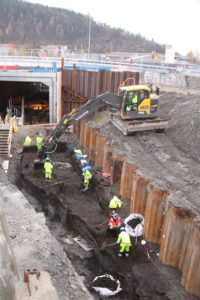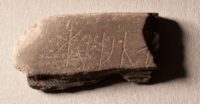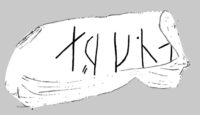 Archaeologists excavating in Oslo, Norway, have discovered a medieval whetstone inscribed with puzzling runes. The Norwegian Institute for Cultural Heritage Research (NIKU) was digging there as part of the Follo Line Project, an archaeological survey of the path of a new railway being built between Oslo and Ski. The railway culvert will run through Oslo’s old medieval center, hence the need for a careful archaeological exploration of the site.
Archaeologists excavating in Oslo, Norway, have discovered a medieval whetstone inscribed with puzzling runes. The Norwegian Institute for Cultural Heritage Research (NIKU) was digging there as part of the Follo Line Project, an archaeological survey of the path of a new railway being built between Oslo and Ski. The railway culvert will run through Oslo’s old medieval center, hence the need for a careful archaeological exploration of the site.
In late October, the team unearthed a small but comparatively thick piece of slate from the smallest trench. The stratigraphy indicated it was medieval, dating between 1050 and 1500. The archaeologist who found it noticed with his keenly trained eye that one side of it was inscribed with some runes. This made the little slate a very large discovery because few runic inscriptions have been found in proper archaeological excavations. Later examination identified the slate as a fragment of a whetstone. Whetstones with runic inscriptions are even more unusual. One three other have been found before in Norway, one from the Viking period, two from the Middle Ages.
 The runes weren’t quite legible on the freshly excavated slate, nor could they be read in photographs. It had to go to a laboratory and be viewed under a microscope to identify which runes were used and to begin to unravel the inscription. Experts have been struggling to solve the runic puzzle ever since.
The runes weren’t quite legible on the freshly excavated slate, nor could they be read in photographs. It had to go to a laboratory and be viewed under a microscope to identify which runes were used and to begin to unravel the inscription. Experts have been struggling to solve the runic puzzle ever since.
Some of the runes are difficult to identify, but it seems that the runes æ, r, k, n, a appear on the whetstone. But it is not easy to tell what they mean.
NIKU’s rune experts have come up with several possible interpretations, ranging from a person’s name to word to words like “scared,” “ugly” and “pain.”
“This is probably an unsuccessful attempt to write a name or another rather trivial inscription, but we can see that this is hardly a trained rune carver,” says Karen Holmqvist, a Ph.D. fellow at NIKU and a specialist in runes.
The findings contribute to the perception that the art of runic writing was relatively widespread in medieval Norway. But many writers would probably find themselves in a borderland, where they knew about writing, but were not literate.
“It is perhaps not that strange that we find some strange spellings and some mirrored runes. Just think how you yourself wrote when you were learning to write,” says Holmqvist.
The medieval person behind this whetstone inscription probably belonged to this group. They knew about the runes, but probably mixed them up a bit.
 That’s a kind way of putting it. According to a blog entry co-authored by Kristine Ødeby, archaeologist and field supervisor on the Follo Line excavations, and Karen Holmqvist, the runes can read in a multitude of ways, and this carver seems to have been inconsistent and confused. Runes are confusing enough as it is, with a lot of variables to account for in their interpretation. It’s hard to tell which way is up, for example (literally, not metaphorically). It’s also not certain whether they were written left to right or right to left. (Runes are flexible like that, and it wasn’t until later in the Middle Ages that left to right runic inscriptions became the norm.)
That’s a kind way of putting it. According to a blog entry co-authored by Kristine Ødeby, archaeologist and field supervisor on the Follo Line excavations, and Karen Holmqvist, the runes can read in a multitude of ways, and this carver seems to have been inconsistent and confused. Runes are confusing enough as it is, with a lot of variables to account for in their interpretation. It’s hard to tell which way is up, for example (literally, not metaphorically). It’s also not certain whether they were written left to right or right to left. (Runes are flexible like that, and it wasn’t until later in the Middle Ages that left to right runic inscriptions became the norm.)
Ødeby and Holmqvist ask readers to comment with any suggestions and ideas for possible interpretations, so if you speak fluent rune (or even just read Norwegian so you don’t have to rely on terrible online translators like I do), chime in with your ideas about what our whetstone-carving friend might have been trying to say.